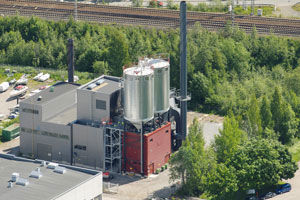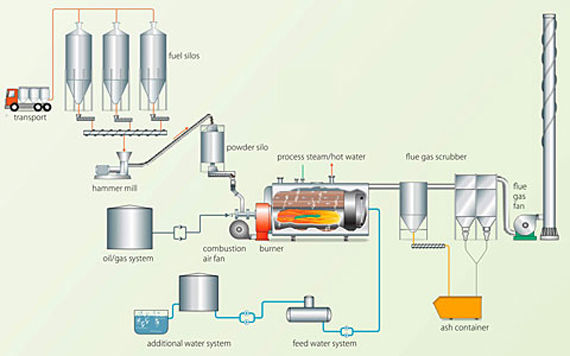Sustainability in district heating through pellet firing
May 20, 2014

All efforts to decrease the environmental load in power generation are needed to reach sustainability targets. Using wood pellets – carbon neutral, high-quality biofuel – offers a viable alternative in district heating. The new pellet-fired heating plant at Tampereen Energiantuotanto Oy in Tampere, Finland, sets a good example with Valmet’s Bioheat RampUp solution and advanced automation technology.
Bioenergy is something in which Tampereen Energiantuotanto strongly believes and wants to promote in its operations. The company, a subsidiary of Tampereen Sähkölaitos (Tampere Power Utility), is responsible for the group’s electricity and district heat production, maintenance and development. In late 2012, the company started up a new 33 MW pellet-fired heating plant that is used as a peak load and backup plant. The plant, located in the Sarankulma industrial area in Tampere, was supplied by Valmet and is the largest of its kind in Finland.

The new 33 MW pellet-fired heating plant in Tampere has aroused much interest since it is the largest of its kind in Finland.
“We consider the pellet-fired plant a good addition to our long-term heating plant palette. Increasing the proportion of renewable energy sources is part of our strategy,” says Timo Heinonen, Development Manager, Tampereen Energiantuotanto.
With the new plant, the company has been able to replace some of the capacity of the existing oil- and gas-fueled boiler plants and thus boost sustainability. Replacing the old boilers with a new modern pellet-fired boiler significantly reduces the company’s CO2 emissions resulting from the production of district heating.
“We wish to be at the forefront in sustainable energy generation in Finland. District heating has always been an efficient and environmentally friendly alternative, and it will remain so in the future as well,” Heinonen emphasizes.
Technologies combined in a new way
Tampereen Energiantuotanto selected Valmet to supply the environmentally friendly pellet-fired heating plant. Valmet’s Bioheat RampUp solution utilizes existing technologies to form a new combination of pulverized combustion technology and traditional water boiler technology.
The technology used at the 33 MW plant is based on pellet fuel being pulverized in separate grinding mills and burned in a pulverized combustion boiler. The start-up and load control of the combustion process is extremely high, and the pulverized fuel allows for clean, energy-efficient and flexible heat generation.
The wood powder burner is a multi-fuel burner that can be fired with gas or oil in addition to wood powder, if necessary. It has also a light oil firing possibility with a 47 MW firing rate.

Flow chart of a pellet-fired plant.
“This solution brings new opportunities to gear the structure of district heat production towards the goals of sustainable development. Pellets represent CO2 neutral, renewable energy and thus do not harm the environment,” comments Teemu Koskela, Sales Director, Bioheat business, Valmet. “Another major benefit is that pellets are cheaper to use than oil or gas, so they lower fuel costs.”
Koskela emphasizes that using wood pellets as fuel presents an easy-to-use and reliable solution not only for peak load and backup plants but also for demanding process steam production in various industries. Valmet has already supplied pellet-fired plants, for example, to the food industry and large laundries.
All plants under one system
The Sarankulma pellet-fired plant is unmanned and equipped with a complete Metso DNA automation system, which is fully integrated into the Metso DNA system used at Tampereen Energiantuotanto’s other production facilities. Having all plants under one automation system brings many benefits.
“The installed equipment base is smaller, and the automation environment is simpler. There are also fewer places that can fail, adding to better availability and reliability,” lists Pentti Iso-Pietilä, Production Service Manager at Tampereen Energiantuotanto. “Additionally, our operators’ capabilities improve, system upkeep is easier and there is less system maintenance. And upkeep and maintenance costs are lower – or at least we hope this will be the case in the future.”
“By using reliable automation technology, the operators are able to flexibly control the district heat production process and react to load variations,” explains Heikki Mylläri, Sales Director, Automation, Metso.
With the history data that the system collects from the process, the users are able to follow how the process develops, learn from earlier situations and avoid the same problems in the future. Plant safety is ensured by a safety interlocking system.
“And as there are no barriers between the systems, changes only need to be made in one system,” Mylläri continues. Other benefits include having the same spare parts and the possibility to expand the system, for example, by adding condition monitoring to the Sarankulma plant.
Controlled locally or from kilometers away
The unmanned plant is controlled via a remote broadband connection from the company’s main control room at the Lielahti power plant, about ten kilometers away. The same displays and functions are available also locally at the plant. Having the same user interface, data collection, reporting and engineering tools at both locations improves process operability, controllability and availability.
“We have minimal control room operator resources, so remote control is beneficial for us in this respect. It also makes it clear how to manage production entities,” Iso-Pietilä points out. “And creating backup connections is simpler, since there is no linkage.”
All set for the next heating season
Experience gained last winter with the pioneering pellet-fired plant in Tampere has been positive. Pulverized fuel has allowed clean, energy-efficient and flexible heat generation during start-ups and quick load changes during production.
The plant’s control capability has fulfilled the requirement of the district heating network of Tampere, a city of circa 220,000 inhabitants. Plant efficiency and availability have been at a high level. Also, flue gas emissions requirements have been met; wood pellets are fired with low CO and NOx emissions.
So, everything is all set for the next heating season. Just by pushing a button at the main control room kilometers away, the pellet-fired plant will go on stream when needed and provide heat for housing and other facilities in the southern parts of the city.